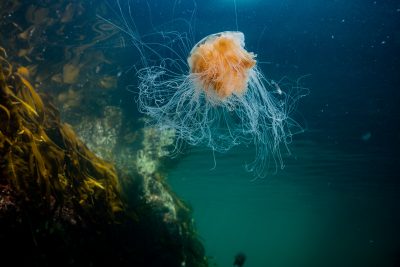Wanted - turtle and jellyfish spotters

If you go down to the beach today and spot a jellyfish or turtle, the Marine Conservation Society wants to hear from you.
The charity is asking beach and seagoers to share any discoveries of the marine animals in UK and Irish waters, as part of the society's long-running wildlife sightings project. Those taking part will be contributing to vital research helping to protect oceans and wildlife.
Both jellyfish and turtles are key species that are of particular interest to researchers this summer. Both are vital in supporting ocean biodiversity and are indicators of climate change while being at risk from its impacts.
During spring and summer, jellyfish arrive in the UK’s warming waters to feed on plankton blooms - or anything small enough to get caught, such as eggs and larvae of fish, crustaceans, starfish and molluscs.

With healthy fish stocks and rich biodiversity, jellyfish quickly become part of an effective food chain and are especially appealing to marine turtles. As a result of jellyfish blooms in spring and summer, six of the world’s seven marine turtle species have been spotted in UK seas.
The largest sea turtle, and the most common in UK seas, is the leatherback which has a ‘vulnerable’ conservation status. Reporting sightings of these incredible creatures will support the Marine Conservation Society and others in understanding their movements, potential threats and how to better protect them.
For more than 17 years, beachgoers have been contributing to scientific research by sharing their wildlife sightings with us. It's a key part of our work."
Amy Pilsbury, citizen science project lead at the Marine Conservation Society, said: “For more than 17 years, beachgoers across the UK have been contributing to scientific research by sharing their wildlife sightings with us. It's a key part of our work and plays a vital role in better understanding and protecting our ocean.”
There are eight different jellyfish, or jellyfish-like, species and six marine turtles that you might see in our waters. For more information or to share what you have spotted www.mcsuk.org/
Fascinating facts about jellyfish from MCS
Jellyfish have been bobbing along in our ocean for over 500 million years - that's longer than dinosaurs
They are 95% water and don’t have brains, hearts, or lungs
Jellyfish are a type of cnidarian. Named after the Greek word for sea nettle, cnidarians are jelly-like marine animals which have radical symmetry and sting their prey using cells on their tentacles
Life as a jellyfish begins as a polyp, before they become an ‘ephyra’ and then an adult ‘medusa’. But, if injured, starved, or in water which is either too hot or cold, some species can drop to the seabed and become a polyp all over again.

